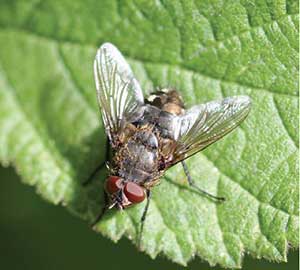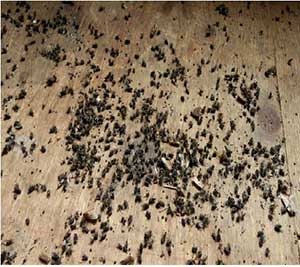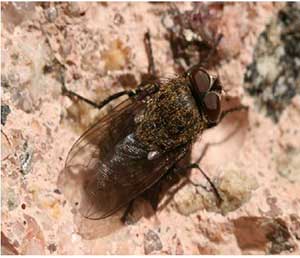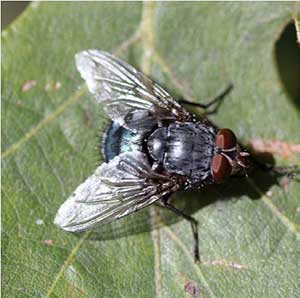by W. Cranshaw* (2/18)
Quick Facts…
- Cluster flies frequently use buildings for winter shelter and can be the most common fly found indoors during the cool season.
- Cluster flies develop by feeding on earthworms.
- Cluster flies found in buildings are in a dormant state and cannot reproduce indoors.
- Sealing buildings by prior to when cluster flies enter in late summer can limit nuisance
indoor problems the flies in winter and early spring. - Other flies that will use buildings for winter shelter include blue bottle flies and the black blow fly.
During the cool months some insects have the habit of moving into buildings as a temporary winter shelter. Common examples of such cool season “nuisance invaders” are boxelder bugs, western coniferseed bug, and elm leaf beetles. Cluster flies (Pollenia species) are the most common of the flies that often use buildings as a temporary shelter through winter.
Cluster flies tend to be particularly common in higher elevation communities, but problems with cluster flies within buildings can occur statewide. Most often they are a problem where there are nearby areas of irrigated turfgrass, near streams or rivers, and other sites where soils are moist.
 Fig. 1. Cluster fly |
Cluster flies are dull grayish-brown flies about 3/8-1/2-inch long, slightly larger than a house fly. They may be noticed within buildings from early autumn through spring and sometimes occur in large numbers. When active the flies are in a semidormantstate and fly lazily and somewhat erratically. More often cluster flies are noted when they are dead or dying, typically around windows.
There are some other kinds of flies that will be found indoors and these are reviewed in Fact Sheet 5.502 Flies in the Home. Among these are some other “winter flies” that use homes for winter shelter, particularly the “blue bottle flies” (Calliphora species) and the black blow fly (Phormia regina). The habits of these differ in some important ways from those of cluster flies and are discussed below.
Life History and Habits of Cluster Flies
Cluster flies are not a type of “filth fly” that develops in carrion, decaying plant matter or garbage. Instead the young stages are predators of other small animals and most, if not all, cluster flies in North America feed on certain earthworms (e.g., Aporrodectodea rosea, Allobophora chlorotica). Although these earthworms are introduced European species, not native to Colorado, these are now widely found in irrigated lawns and pastures and along waterways.
Three species of cluster flies are common in Colorado: Pollenia pediculata, P. angustigena, and P. rudis. All are slightly similar in size and are a dull grayish-brown but many have irregular light patches on the abdomen. A feature that can be used to distinguish cluster flies from some similar flies (e.g., blue bottle flies, black blow fly) is the presence of golden, tangled hairs on the thorax (the region of the body that includes the wings and legs). The adult flies feed on water and other available liquids, such as nectar.
Active cluster flies can be found outdoors from early spring through much of autumn. They are most often present on turfgrass and other sites where earthworms are present. Female flies will lay their eggs in soil crevices and when the egg hatches the tiny larva (maggot) that emerges will migrate into the soil seeking an earthworm. When they locate a host earthworm, the larva of the cluster fly will penetrate the body and feed within the earthworm, ultimately killing it. The developing larvae become full-grown in about 2 to 3 weeks, then pupate in the soil. Adults subsequently emerge to produce a second generation, repeating the cycle. As many as four generations may be completed during the growing season.
Cluster flies shift their behavior as day length shortens in late summer. Adults cease reproduction and instead seek dry, sheltered areas suitable for survival through winter. Buildings provide many cluster flies the crevices and cavities that make good overwintering sites.
Beginning as early as mid-August and extending into early October, cluster flies increasingly can be seen resting on sun-warmed (south, west) walls of buildings. If there are any entry points – cracks around window or soffits, incompletely sealed ventilation openings, unsealed areas of building siding – cluster flies will enter. Upon entry into the building cluster flies then find sheltered areas in wall voids or attics where they may aggregate in loose clusters. (Lending them the name “cluster fly”). Areas where cluster flies particularly concentrate are on the upper stories of buildings and “attic fly” is another common name applied to these winter visitors of buildings. Once within a building cluster flies can spread throughout a building, moving through available openings, such as in cavities behind walls and areas provided above a suspended ceiling.
 Fig. 2. Mass of dead cluster flies on an attic floor |
 Fig. 3. Cluster fly sunning on a south wall on late October |
For the cool season months, beginning in early autumn, cluster flies remain in a dormant state, moving little if at all, usually clustered together. During this time cluster flies cease reproduction, slow down their metabolism, and are in a dormant (diapause) period that allows them to survive through spring. They will remain in this inactive state for many months, but will stir a bit during warm, sunny periods. At this time some of the dormant flies may incidentally wander into the living areas, producing nuisance problems.
Normally, few of the cluster flies that spend winter in buildings end their life by dying indoors. The great majority that spend winter within cavities of a building ultimately move outdoors in early spring, repeating their normal life cycle.
Management of Cluster Flies in Buildings
Physical Exclusion.
The fundamental step to prevent problems with cluster flies is to effectively seal building openings in a way that blocks all entry points used by cluster flies. In the absence of a means that seals out these insects, it is not possible to control cluster fly problems within buildings. All other methods used to control cluster flies supplement this approach.
Buildings must be sealed prior to when cluster flies move into wall voids and attic areas. Cluster flies begin to move into buildings for winter shelter in late August, and most move in during September. Potential entry points should be sealed by mid-August and certainly no later than Labor Day.
When sealing buildings, all cracks and crevices around windows, unscreened ventilation sites around eaves, and other exterior openings that allow flies access to interior areas of buildings must be sealed with caulking (and/or silicone) or other methods to eliminate points where insects may enter. Particular attention should be given to sealing sites on sun-exposed sides (south, west) and upper areas of the building where cluster flies are most likely to enter.
Chemical Exclusion.
The value of insecticides to manage cluster fly problems is limited and involves two primary uses. Residual insecticides can be applied as sprays targeted to cracks/crevices on the building exterior in late summer. This application could kill some flies before they move behind walls or cause them to die shortly afterwards. This use of insecticides is effective as a supplement to (not a substitution for) the primary management focus of sealing entry points used by cluster flies. Various pyrethroid insecticides – containing active ingredients such as permethrin, bifenthrin, lambda-cyhalothrin, cyfluthrin – are used for these treatments. Both over-the-counter and commercial formulations exist for all of these insecticides. However, for control of cluster flies all insecticides should be only be used as targeted applications to cracks and crevices, such as around the outside of windows or openings in soffits.
Drying Dusts Applied behind Walls.
The second type of insecticide application is the use of a desiccant/drying dust type of insecticide that is injected into areas (voids) behind walls and other sites where cluster flies aggregate. This can kill cluster flies (and some other insects) that have managed to find their way into a building, which prevents their later movement into living areas. However, any dead flies that remain behind walls may later attract the attention of rodents, dermestid beetles and other scavengers.
Two types of desiccant dusts are marketed, diatomaceous earth (DE) and silica aerogel (SA), both of which are types of silicon dioxide (the primary constituent of sand). However, these drying dusts have a specific physical structure, either produced as the fossilized remnants of hard cell walls produced by diatoms (DE), or as a synthesized structure that is very light and highly absorptive (SA). In powder forms these can be applied as dusts that on contact can disrupt the protective wax layer on the surface of insects, causing them to die by drying out (desiccation). Some formulations of these desiccant dusts are also combined with insecticides, particularly pyrethrins.
Effective use of desiccant/drying dusts involves use of special application equipment and usually requires the use of a professional pest control operator.
Light Traps Used in Areas behind Walls, in Attics.
Cluster flies are not attracted to most “fly traps”, such as fly paper or traps that have food/chemical lures. However, light traps can be attractive and placed strategically within buildings and can be used to assist control of cluster flies in some situations.
One place where these lights can be useful would be areas of buildings with large open areas where cluster flies aggregate, such as in attics. Cluster flies may also move through corridors, such as those provided by suspended ceilings and light traps in these sites can intercept migrating cluster flies.
Light traps to attract cluster flies use ultraviolet (UV) lights. The insects are then attracted to a sticky surface where they are trapped. If very large numbers of cluster flies are present within the building, traps often will fill with trapped flies and need replacement.
Larval Control Outdoors.
Young stages of cluster flies develop in soil, feeding on their earthworm hosts. It is sometimes suggested whether insecticides applied to lawns at this time will reduce later problems with adult flies in buildings. It will not. This type of insecticide use has never been shown to kill developing cluster flies. Also, the adult flies seeking winter shelter can fly long distances and the flies present in a building may have originated at sites several hundreds of yards distant.
Other Winter Flies
 Fig. 4. Black blow fly |
 Fig. 5. Blue bottle fly |
A few other flies will also use homes as shelter during the cool months. Most common are the “blue bottle flies” (Calliphora species) and the black blow fly (Phormia regina). Both of these are roughly similar in size and shape to cluster flies but lack the distinguishing golden hairs on the body. Blue bottle flies can be distinguished by an abdomen that is dull metallic blue.
These flies have very different feeding habits than do cluster flies. Instead of developing as a predator of earthworms, both blue bottle flies and the black blow fly develop as scavengers in their immature form, feeding on recently dead animals (carrion), meat products, and garbage. Also, blue bottle flies do not go into a fully dormant state in winter and may reproduce year-round as long as temperatures allow and food sources for their young are available. The black blow fly, like cluster flies, go into full winter dormancy (diapause) and suspend reproduction through winter.
Controls for these flies are similar to those of cluster flies, which primarily focuses on sealing buildings prior to the flies taking up residence in the buildings during late summer to autumn.
*Whitney Cranshaw is an Extension Specialist and Professor of entomology at Colorado State University. 2/18.





